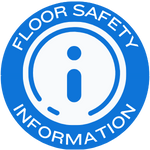Why Should I Test My Floor?
In many public spaces, the owner of the facility/property bears the responsibility of providing a safe walkway to ensure the safety of employees, customers and basically anyone that will be walking on that surface.
If a floor is below the threshold of what is considered a safe floor, and someone suffers and injury due to a slip and fall, the property owner can be held responsible for the damages. The property manager won’t be able to argue in court that they didn’t know the floors were slippery.
The first step to providing safety is knowledge. You should know whether or not your walkways are compliant with all floor safety standards.
What Types of Floors Should Be Tested?
In our experience, we have seen plenty of people install rough looking tiles around their pool decks because they believed that they were slip resistant, when in reality, they were very slippery and dangerous. The appearance and the feel of a tile does not determine if it is slip resistant. Every floor should be tested, regardless of how it feels or how it looks.
Our rule of thumb is to think about whether or not you can argue this in court…
YOU: “Your honor, the floor felt pretty rough when we touched it, we thought it was safe.”
JUDGE: “Was it tested by an approved method of testing slip resistance?”
YOU: “No.”
… you can imagine the rest of that scenario, I’m sure.
Whether you have a ceramic, porcelain, granite, slate, marble, concrete, glass, metal, plastic, vinyl, laminate, wood floor… you should test your floors to know where they stand in comparison with the Floor Safety Standards.
Floor Safety Standards
There are two types of measurements that are used to determine slip resistance, Static Coefficient of Friction (SCOF) and Dynamic Coefficient of Friction (DCOF).
SCOF is the measurement of the amount of friction existing between two surfaces at rest. Basically, how much pressure is needed for someone standing completely still, to slip and fall.
DCOF is the measurement that determines how much friction there is on a wet, level floor when it is walked upon. Basically, how much pressure is needed for someone to slip and continue slipping when they are in motion.
In the United States, there is only one standard that is acceptable for measuring slip resistance. It is the ANSI A326.3 which tests for the DCOF of a surface and requires the DCOF to measure above a 0.42 to be compliant with the standard.
The current standard calls for any surface that can be installed indoor, to be at 0.42 when wet.
According to Tile-Magazine, In 2022, the standard is set to be updated and will call for a few more categories:
-
Interior, Dry
-
Interior, Wet
-
Interior, Wet Plus
-
Exterior
-
Oils/Greases
The machine used to test the DCOF is called the BOT 3000e by Reagan Scientific Instruments, a company that is part of the Walkway Management Group Network.
Cost of Testing
Walkway Management’s system for slip resistant testing is accompanied with a fully detailed report that is fully compliant with the ASTM F1694-14 “Standard Guide for Composing Walkway Surface Investigation, Evaluation and Incident Report Forms for Slips, Stumbles, Trips and Falls.”
This report can and should be used in the court of law, demonstrating due diligence in being proactive in ensuring a safe walkway for your employees and customers. Having this report can save you several thousands of dollars in lawsuits.
According to the Centers for Disease Control and Prevention (CDC), the average hospital cost of a slip and fall accident is $40,000. The cost of slip testing is extremely small in comparison.
For more information about slip testing, please contact us at info@wmgsouthfl.com.







